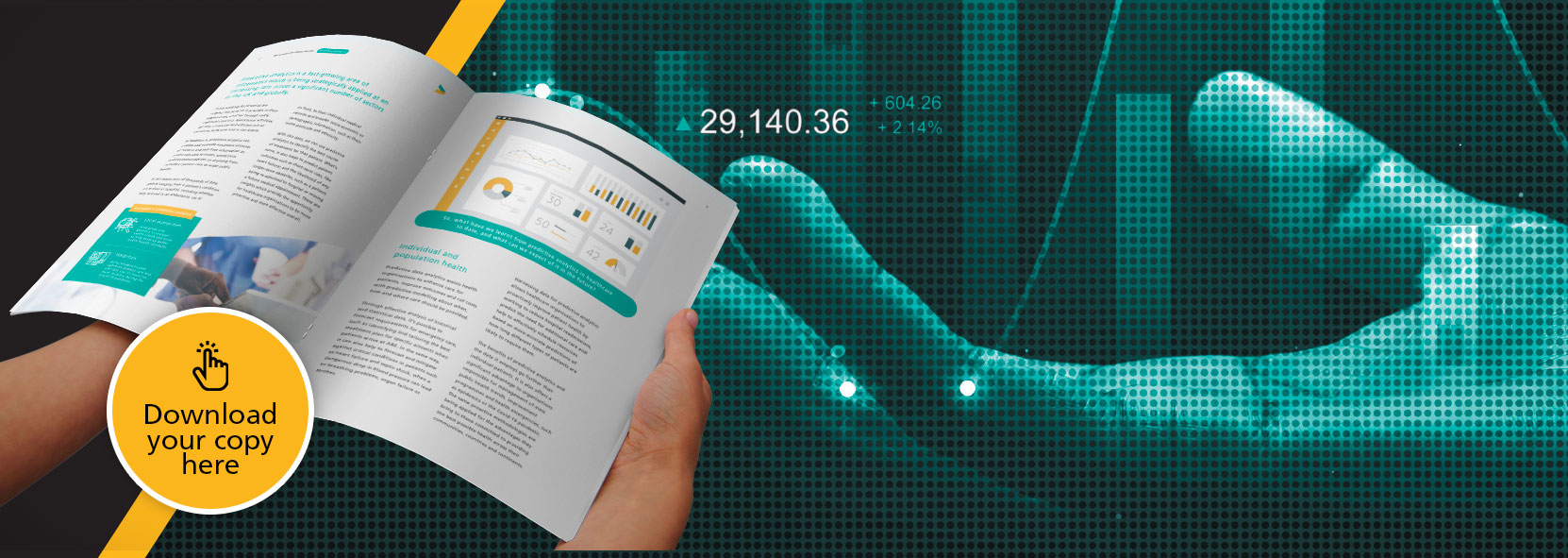Predictive Analytics: An Emerging Asset in the Healthcare Industry
Those realising its potential are reaping the benefits it provides to their organisation, whether through vastly improved planning, operational activities, delivery of services and efficient use of resources, both now and in the future.
In healthcare, predictive analytics can process and evaluate enormous amounts of historic and real-time information to create valuable forecasts, predictions and recommendations on anything from individual patient care to wider public health.
It can assess tens of thousands of data points ranging from a patient’s condition on arrival at hospital, including whether they arrived in an ambulance, car or on foot, to their individual medical records and broader socio-economic or demographic information, such as their home postcode and ethnicity.
With this data, we can use predictive analytics to identify the best course of treatment for that patient. What’s more, it also helps to predict patient outcomes such as short-term risks, like heart failure; and the likelihood of any longer-term obstacles, such as a patient being re-admitted to hospital or missing a future medical appointment. These are insights which provide the opportunity for healthcare organisations to be more proactive and more effective overall.

Examples of predictive analytics
Local authorities
Using predictive analytics to evaluate health trends and issues to help draw-up better public health strategies.
Hospitals
Using insights to plan optimum patient care and efficient use of resources, most recently during the Covid-19 pandemic.
So, what have we learnt from predictive analytics in healthcare to date, and what can we expect of it in the future?
Individual and population health
Predictive data analytics assists health organisations to enhance care for patients, improve outcomes and cut costs with predictive modelling about when, how and where care should be provided.
Through effective analysis of historical and statistical data, it’s possible to forecast requirements for emergency care, such as identifying and tailoring the best treatment plan for specific ailments when patients arrive at A&E. In the same way, it can also help to forecast and mitigate against critical conditions in patients such as heart failure and septic shock, when a dangerous drop in blood pressure can lead to breathing problems, organ failure or strokes.
Harnessing data for predictive analytics allows healthcare organisations to proactively improve patient health by working to reduce hospital readmissions, predict the need for additional care and help to effectively schedule resources based on more-accurate predictions of how long different types of patients are likely to require them.
The benefits of predictive analytics and the data it employs go further than individual patients. It is also offers a significant advantage to organisations responsible for management of mass public health trends, improvement programmes and health emergencies, such as epidemics or the Covid-19 pandemic. The same proactive methodologies are being applied for the advantages they bring to those committed to providing the best possible health across their communities, countries and continents.
Pressures, trends and developments
Factors such as an ageing population, increasing chronic conditions and financial costs are putting ever-growing pressures on our healthcare sectors both in the UK and globally. One of the responses to these pressures is the move to a new payment and funding models which place an emphasis on the outcomes and quality of care provided by healthcare organisations, rather than volume.
Predictive analytics is helping organisations to make the transition to these new models as they contribute to achieving the improved patient care and outcomes whilst also reducing costs.
Thanks to the growing digitalisation of healthcare, which is developing at pace, the sector is now generating huge new data sets from an increasing number of sources. Examples include electronic medical records, laboratory results,
adiology images and health claims data. DNA and genomics are other emerging areas where electronic data is expected to grow.
The following devices are also generating highly valuable data
- Medical monitors
- Patient wearable devices
- Fitness trackers and health apps
Healthcare data from all available sources can be fed into predictive analytics and analysed in any number of ways to support the proactive, efficient and streamlined delivery of care, risk mitigation and administering of precision
medicine.
With so much data readily available, a key consideration for healthcare organisations is having access to suitable hardware and software to process vast amounts of data and analyse it for clinical results. Data governance plans are also needed to ensure the highest security standards are adhered to in the process. Yet some organisations lack this resource and are missing out predictive data opportunities.
Informatics experts, like The Health Informatics Service (THIS), exist to assist healthcare organisations in all these requirements, enabling clients to safely, accurately and efficiently move, store and process data for predictive analytics.

The benefits in action
Predictive analytics should be a key element in any health analytics strategy for its ability to measure, aggregate and sensecheck biometric, behavioural and psychosocial data which was previously hard to collect or not available.
We can see how, for individual patients, it enables care providers to give the correct care at the best time to the right patient. Predictive analytics uses learnings from historical data to highlight patients at risk from chronic conditions and flag-up potential obstacles to the successful delivery of their care plans. By helping carers to stay ahead of events they can provide the most appropriate and timely care to prevent their condition becoming critical. If needed, rapid response teams can be alerted to risk cases and prepare to intervene at short notice.
All in all, risks are spotted earlier and more widely among patients, so treatment is delivered earlier, recovery is earlier and hospital resources are saved.
From an operational perspective it contributes to bed occupancy prediction by accurately predicting the lengths of stay and hospital readmission rates for individual patients, which in turn helps to boost availability, increase treatment provision and reduce operational expenses and penalties.
Data can even identify patients who are more likely to miss appointments, so to avoid wasted time and cost, they can be supported to attend through helpful reminders.
Overall, predictive analytics leads to better operational efficiencies, improved patient safety and improved patient outcomes. For wider public health trends and issues, it provides a better understanding of largerscale developments and helps to draw-up better public health strategies.
There’s no doubt that predictive analytics has played a key role during the Covid-19 pandemic. For example, in the US, The National Minority Quality Forum (NMQF) launched the Covid-19 Index which combined historical data from March 2020 onwards with datasets from public and private sources to generate a map of localised viral trends that forecast viral surges before they reached a critical stage.
" In the UK, THIS launched a similar predictive analytics model to help identify and manage potential surges in hospitals run by the Calderdale and Huddersfield NHS Foundation Trust, within which THIS sits. "
Tried and tested in a pandemic
Our predictive analytics systems have been applied successfully in some highly challenging operational situations, most recently during the peaks of the Covid-19 pandemic.
Our solutions have helped NHS hospital teams to respond and plan for large surges in demand for intensive care, which required the escalation of clinical staff, beds and equipment into ICU.
Predictive analytics helped hospital teams to estimate bed occupancies and staffing requirements from different departments through the turbulent peaks and troughs of 2020 and 2021.
As Covid-19 cases began to decline, predictive analytics enabled the organising of clinical nursing staff to return back to their substantive (pre-pandemic) roles. We worked closely with clinical, statistics and information staff on the data we fed into our modelling systems. Such data included the number of patients arriving each day across the hospital who tested positive for Covid-19 and the correlation of the number of patients who would then be in ICU nine or ten days later.
The success of predictive analytics was evident in the adjacent graph showing the actual number of ICU patients per day against our predictions. The pattern of predicted peaks and falls mirrored the actual bed occupancy extremely accurately and there was an 80 to 90 per cent confidence in our predictions.

Hardware, software and bespoke solutions
Having reliable, secure and intelligent hardware and software is a crucial requirement if our healthcare organisations are to take full advantage of predictive analytics. It requires technical infrastructure
such as a data warehouse and a knowledge portal to access workstreams like the Knowledge Portal Plus or our Covid ICU Prediction App which have been developed with extensive knowledge of the needs of healthcare
providers at the core. Not to mention highly skilled and experienced analysts who can operate the system and extract the valuable insights.
Our specialists at THIS can advise on and provide the full extent of these key requirements to help integrate a bespoke predictive analytics system into your healthcare organisation. By partnering with THIS, predictive analytics can be easily coordinated to help you reduce operational costs, improve patient outcomes, and increase the effectiveness of resourcingwithin your organisation.
Having already developed and delivered a range of tried and tested predictive analytics models to our NHS partners, we’ve seen first-hand how it has successfully been used
to offer the best patient care and effective, efficient use of hospital resources.
As the ever-changing healthcare landscape evolves, so too do our services and solutions. Owing to the success and value of recent projects in NHS healthcare and the wider growth of digital health solutions, we continue to expand and optimise our predictive analytics service.
At THIS, we take great pride in our established reputation and proven track record of timely delivery, accuracy and innovative informatics solutions. As part of the NHS, our analysts have many years’ experience of working with clinical data across all care settings and our solutions and services are fully compliant with NHS data and IT standards.

Subscribe to Informatics Insights & Advice
Take advantage of the latest news and information from The Health Informatics Service. Read about our innovative work with healthcare clients across the UK and get our expert insights and recommendations to help and inspire your work.


